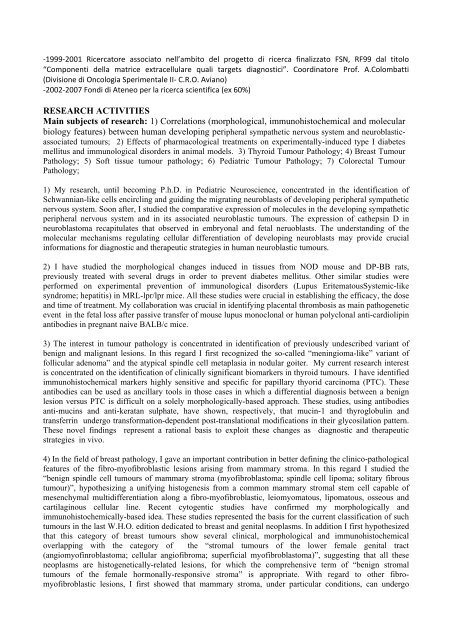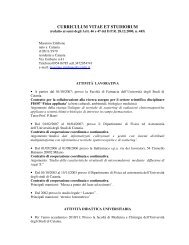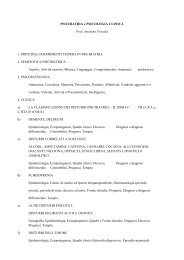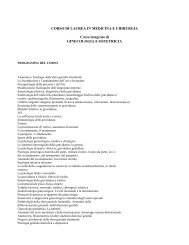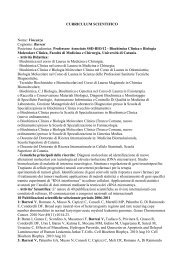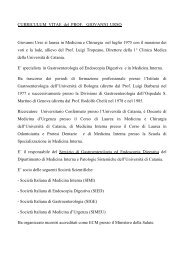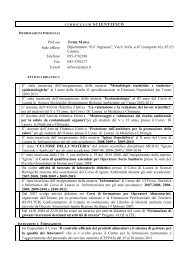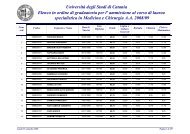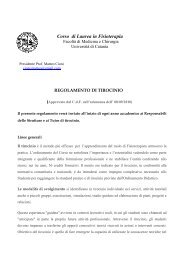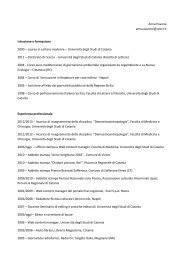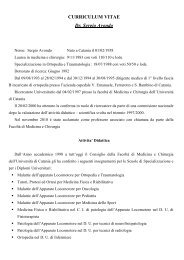Prof. Gaetano Magro - Medicina
Prof. Gaetano Magro - Medicina
Prof. Gaetano Magro - Medicina
- No tags were found...
Create successful ePaper yourself
Turn your PDF publications into a flip-book with our unique Google optimized e-Paper software.
‐1999‐2001 Ricercatore associato nell’ambito del progetto di ricerca finalizzato FSN, RF99 dal titolo“Componenti della matrice extracellulare quali targets diagnostici”. Coordinatore <strong>Prof</strong>. A.Colombatti(Divisione di Oncologia Sperimentale II‐ C.R.O. Aviano)‐2002‐2007 Fondi di Ateneo per la ricerca scientifica (ex 60%)RESEARCH ACTIVITIESMain subjects of research: 1) Correlations (morphological, immunohistochemical and molecularbiology features) between human developing peripheral sympathetic nervous system and neuroblasticassociatedtumours; 2) Effects of pharmacological treatments on experimentally-induced type I diabetesmellitus and immunological disorders in animal models. 3) Thyroid Tumour Pathology; 4) Breast TumourPathology; 5) Soft tissue tumour pathology; 6) Pediatric Tumour Pathology; 7) Colorectal TumourPathology;1) My research, until becoming P.h.D. in Pediatric Neuroscience, concentrated in the identification ofSchwannian-like cells encircling and guiding the migrating neuroblasts of developing peripheral sympatheticnervous system. Soon after, I studied the comparative expression of molecules in the developing sympatheticperipheral nervous system and in its associated neuroblastic tumours. The expression of cathepsin D inneuroblastoma recapitulates that observed in embryonal and fetal neruoblasts. The understanding of themolecular mechanisms regulating cellular differentiation of developing neuroblasts may provide crucialinformations for diagnostic and therapeutic strategies in human neuroblastic tumours.2) I have studied the morphological changes induced in tissues from NOD mouse and DP-BB rats,previously treated with several drugs in order to prevent diabetes mellitus. Other similar studies wereperformed on experimental prevention of immunological disorders (Lupus EritematousSystemic-likesyndrome; hepatitis) in MRL-lpr/lpr mice. All these studies were crucial in establishing the efficacy, the doseand time of treatment. My collaboration was crucial in identifying placental thrombosis as main pathogeneticevent in the fetal loss after passive transfer of mouse lupus monoclonal or human polyclonal anti-cardiolipinantibodies in pregnant naive BALB/c mice.3) The interest in tumour pathology is concentrated in identification of previously undescribed variant ofbenign and malignant lesions. In this regard I first recognized the so-called “meningioma-like” variant offollicular adenoma” and the atypical spindle cell metaplasia in nodular goiter. My current research interestis concentrated on the identification of clinically significant biomarkers in thyroid tumours. I have identifiedimmunohistochemical markers highly sensitive and specific for papillary thyorid carcinoma (PTC). Theseantibodies can be used as ancillary tools in those cases in which a differential diagnosis between a benignlesion versus PTC is difficult on a solely morphologically-based approach. These studies, using antibodiesanti-mucins and anti-keratan sulphate, have shown, respectively, that mucin-1 and thyroglobulin andtransferrin undergo transformation-dependent post-translational modifications in their glycosilation pattern.These novel findings represent a rational basis to exploit these changes as diagnostic and therapeuticstrategies in vivo.4) In the field of breast pathology, I gave an important contribution in better defining the clinico-pathologicalfeatures of the fibro-myofibroblastic lesions arising from mammary stroma. In this regard I studied the“benign spindle cell tumours of mammary stroma (myofibroblastoma; spindle cell lipoma; solitary fibroustumour)”, hypothesizing a unifying histogenesis from a common mammary stromal stem cell capable ofmesenchymal multidifferentiation along a fibro-myofibroblastic, leiomyomatous, lipomatous, osseous andcartilaginous cellular line. Recent cytogentic studies have confirmed my morphologically andimmunohistochemically-based idea. These studies represented the basis for the current classification of suchtumours in the last W.H.O. edition dedicated to breast and genital neoplasms. In addition I first hypothesizedthat this category of breast tumours show several clinical, morphological and immunohistochemicaloverlapping with the category of the “stromal tumours of the lower female genital tract(angiomyofinroblastoma; cellular angiofibroma; superficial myofibroblastoma)”, suggesting that all theseneoplasms are histogenetically-related lesions, for which the comprehensive term of “benign stromaltumours of the female hormonally-responsive stroma” is appropriate. With regard to other fibromyofibroblasticlesions, I first showed that mammary stroma, under particular conditions, can undergo


